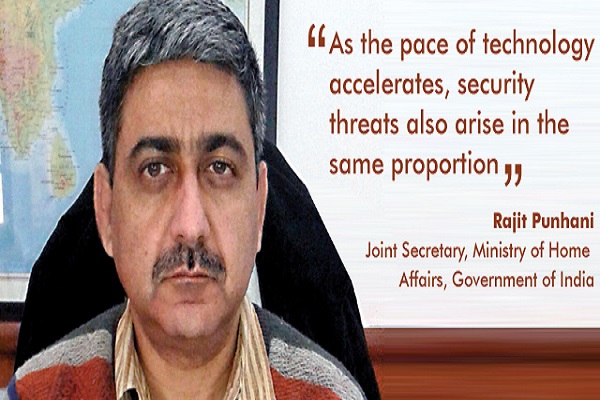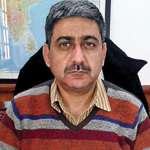
As the pace of technology accelerates and ICT becomes an intrinsic part of people’s behaviours, business practices and government activities, security threats also arise in the same proportion, says Rajit Punhani, Joint Secretary, Ministry of Home Affairs, Government of India, in a conversation with Souvik Goswami of Elets News Network (ENN)
What all issues are handled by the Department of Jammu and Kashmir Affairs?
The Department deals with constitutional, legal and policy matters with respect to the State of Jammu and Kashmir and counter-terrorism measures in that State. The Department also monitors implementation of Prime Minister’s package for the State, special employment initiatives like ‘Udaan’ and other development programmes in J&K.

What kind of ICT initiatives are being implemented in your Department?
There are several ICT initiatives being implemented in our Department, like online visa application system. Through this system, various missions abroad upload the validated visa application data of the people of Pak origin/PoJK, who wish to visit J&K, in the central data server. After getting clearance from security agencies online, the message is conveyed to the concerned mission online.

Besides, we also use the e-Office Management System, which is aimed to conduct office procedures electronically for simplified, responsive, effective and transparent working in government offices; online RTI, which is a portal to file RTI applications online; online Public Grievances portal that aims to provide a platform to the citizens for redressal of their grievances, etc. Also, Udaan, implemented by the National Skill Development Corporation (NSDC), has an online portal, where eligible and interested people can register themselves.
As one of the key policymakers having huge experience in security domain, what are your main security concerns at the moment?
India, with its continental dimensions, varied terrains, large porous land borders, long coastline and ethnic differences poses a complex security challenge. In recent times, internal security has emerged as one of the biggest challenges in India. We have to deal with it in a comprehensive manner covering all dimensions at all levels — political, economic and social. Left wing extremism, cross border terrorism, border security, maritime security, ethnic clashes, and cyber security are currently some of our major security concerns.
How use of ICT can help in ensuring better safety for citizens?
ICT has made remarkable progress in the last decade to ensure better safety for its citizens. It has transformed the country, enabling innovation and increasing productivity, connecting people and communities, and improving standards of living and opportunities across the country. Changing the way individuals live, interact and work, IT has also proven to be a key precondition for enhanced competitiveness and economic and societal modernisation, as well as an important instrument for bridging economic and social divides and reducing poverty.
The pace of technology is accelerating and ICT is increasingly becoming a ubiquitous and intrinsic part of people’s behaviours and social networks as well as of business practices and government activities. These transformations will continue to move human progress forward by further leveraging IT’s potential. On the security front, various technological solutions including night vision devices, GPS/GIS for patrol cars, surveillance camera systems, portable X-ray machines, vehicle number plate identification system, cyber patrol and communication monitoring system etc., have contributed to the safety of our citizens.
What according to you are the challenges before the security agencies nowadays?
At present, there are multiple challenges being faced by our security agencies. In the present context, the popularity of the internet and social media among the youth poses one of the biggest challenges to our traditional security apparatus. Besides, the need for adaptation to the changing environment, close and effective coordination among all the security forces and intelligence agencies is now more vital to maintain peace and order in the country. Also, augmenting technical capabilities (qualitatively and quantitatively) of the police forces to equip them with the state-of-the-art weapons, communication systems and other infrastructural modernisation is the need of the day.
One such measure, the Crime and Criminal Tracking Network and Systems (CCTNS) has been initiated aiming at creating and upgrading the infrastructure across various cities in the country.
Cyber crime is a matter of concern for security agencies. How do you think it can be countered?
Much of our critical infrastructure lies in cyber space which faces challenges from hacking, unauthorised access, financial fraud, data theft and espionage. Any threat of disruption of financial, rail, air, power and critical information services can be construed as an act of terror. Thus, cyber security requires desired priority. The requirements for cyber security are quite dynamic that change with the threat environment. The threat landscape needs to be updated regularly to prevent emerging attacks. Collaboration among various agencies is needed to share information regarding emerging threats and vulnerabilities, which would help in effective protection and prevention of cyber attacks.
It is necessary to take a holistic approach to secure the cyber space. Intelligence collection, collation, analysis and dissemination are prerequisites for success in this regard. One of the key drivers behind cyber security is the technology orgnisations, which demand setting up of state-of-the-art safe networking / communication infrastructure. Also, the constantly increasing computerisation drives across different states and central ministries and sensitive installations demands urgent need to upgrade our cyber security infrastructure.
In recent times, internal security has emerged as one of the biggest challenges in India. We have to deal with it in a comprehensive manner covering all dimensions at all levels — political, economic and social…
This is the age of Social Media, but it also brings along security threats. How it can be tackled?
There are various types of benefits of the social media. But at times, if misused, it becomes a threat to our security. Our experiences have shown that motivated use of the social media can disturb social amity. We need to support judicious use of social media, and mull steps to check its misuse. Further, we need to create a robust mechanism to monitor flow of information and data on different media to help detect, prevent and deter criminal and terrorist actions. At the same time, we need to strike an ideal balance between privacy, freedom, liberty and security and safety of our citizens.
What is your message for the SecureIT event being organised by Elets Technomedia?
I think this is a good forum to discuss various opportunities and challenges that IT provides us. It will give us an insight into how to harness the benefits of IT in order to improve the quality of life of the general populace. I wish all success for the topical and timely event.
Be a part of Elets Collaborative Initiatives. Join Us for Upcoming Events and explore business opportunities. Like us on Facebook , connect with us on LinkedIn and follow us on Twitter, Instagram.












